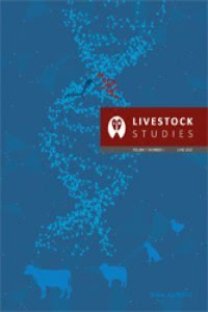SÜT İNEKLERİNDE BAZI MEME ÖLÇÜMLERİ VE SÜT VERİMİ İLE İLGİLİ SUBKLİNİK MASTİTİS ARASINDAKİ İLİŞKİLER
Bu çalışma toplam 5 adet resmi ve özel süt ineği yetiştirmesi ile A. Ü. Veteriner Fakültesi kliniklerine gelen 287 adet sağmal inek üzerinde yapılmıştır. İneklerden bir defaya mahsus olmak üzere 13 ölçüm alınmıştır. Ölçümlerin 11 adedi memeye ilişkin olmuştur. Her meme lobundan alınan süt örnekleri Kaliforniya Mastitis Testi ( CMT) ne tabi tutulmuş ve test sonucu pozitif ya da negatif olarak değerlendirilmiştir. Toplam 287 ineğin 157 sinde subklinik mastitisin (SKM) varlığı tespit edilmiştir. Elde edilen bulgu SKM nun yaygın olduğunu göstermektedir. Yapılan ki kare analizi ırklar arasında SKM olayları yönünden istatistiki önemde farklar olduğunu ortaya koymuştur. En yüksek CMT pozitif tespit % 68 ile Esmer ırkta, en düşük ise % 17 ile Melez grupta bulunmuştur. Sağımın elle ya da makina ile yapılması mastitis olayını etkilememiştir. Bir ve ikinci laktasyon döneminde ineklerin % 45 inde CMT pozitif çıkarken bu oran laktasyon dönemlerinin ilerlemesi ile giderek artmış ve 7. laktasyonun üzerinde olan 14 ineğin tamamında subklinik mastitis bulunmuştur. Günlük ortalama süt veriminin artması ile CMT pozitif rastlantısı yükselmiş ancak farklar ki kare analizinde istatistiki önemde çıkmamıştır. CMT pozitif ineklerin meme çap ve uzunlukları ve günlük ortalama süt verimleri CMT negatif ineklerden daha büyük, meme başlarının yere olan uzaklığı ise daha küçük bulunmuştur (P <0.01). Gerek ön ve gerekse arka memelerde CMT pozitif ineklerin meme başı üst çapları alt çaptan 0.4 cm, negatif ineklerde ise 0.3 cm daha fazla bulunmuştur. Elde edilen sonuçlar süt ineklerinde subklinık olarak seyreden mastitis olaylarının yüksek bir oranda bulunduğunu, laktasyon sayısı ve süt verimi artışının memeyi mastitis etkenlerine duyarlı hale getirdiği ve meme başı çapı ve uzunluğu fazla olan ineklerin mastitise dispoze olduklarını göstermiştir.
The effects of teat measurements and milk production on the onset of subclinical mastitis in dairy cows
The effects of teat measurements and milk production on the onset of subclinical mastitis in dairy cows. The study was conducted on 287 cows. Most of the experimental animals were raised on five dairy farms but sone of the cows were the animals which were brought to the clinics of the Veterinary Faculty for the reasons of other than mammary problems. A total of 13 measurements were taken once from each of the lactating cows. Milk samples were taken from each of the teats for California Mastitis Test and the results were evaluted as pozitive or negative. A total of 157 cows were rated as CMT+ out of 287 animals. This result may indicate that subclinical mastitis (SCM) is wide spreed among the cows. The chi square tests revealed that the differences among the five dairy breeds for the incidence of the SCM were highly significant (P< 0.01). The highest CMT+ readings were found in the Brown (68 %) and the lowest in the crossbreed (17 %) genotype groups. This may be due to the heterosis effect in the crossbred group. No statistical difference was found between hand milked and machine kmilked cows. As the number of lactations were increased the rate of CMT + readings were also increased (P< 0.01). The avarages for the teat diameter, teat length and daily milk yield were higher for tine cows with CMT + then CMT - groups (P < 0.01). The distance from teat end to the ground was lower in the CMT+ group. The differences between upper and lower diameter of the teats were 0.40 cm in CMT+ and 0.30 cm in CMT - groups, indicating funnel shaped teats are more susceptible to subclinical mastitis. İt was concluded that the incidence of SCM is common among dairy cows in Ankara area. The increases in lactation number and milk yield make the mammary gland predisposed to the SCM. Periodical screaning tests should be performed for the detection and treatment of the subclinical mastitis in cows
